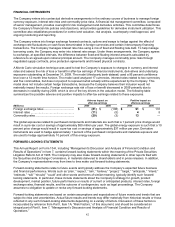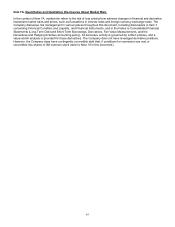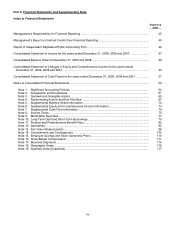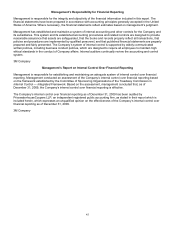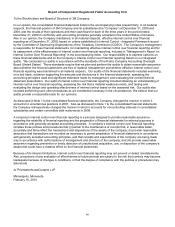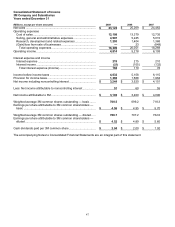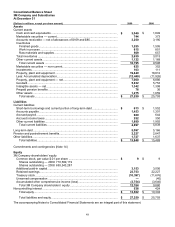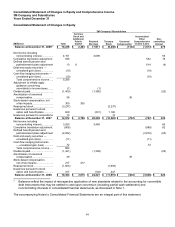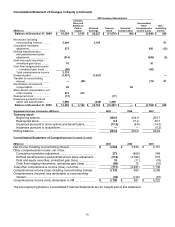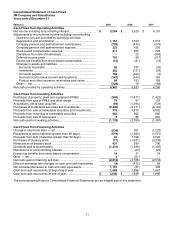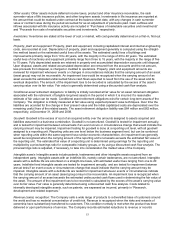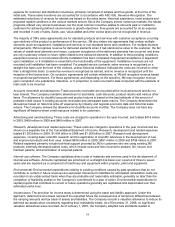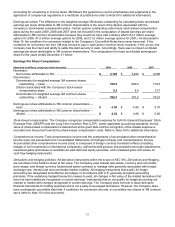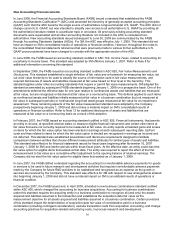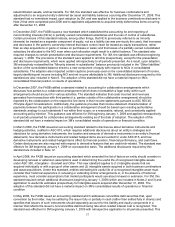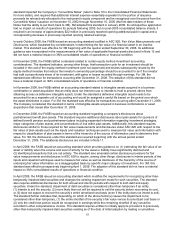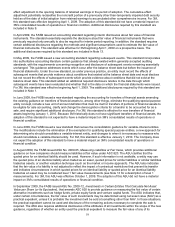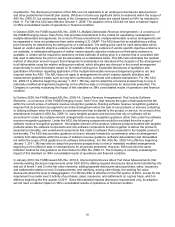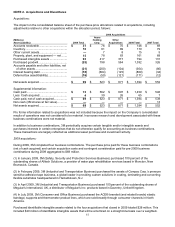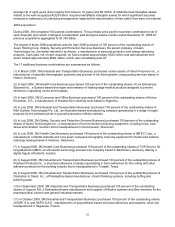3M 2009 Annual Report Download - page 58
Download and view the complete annual report
Please find page 58 of the 2009 3M annual report below. You can navigate through the pages in the report by either clicking on the pages listed below, or by using the keyword search tool below to find specific information within the annual report. 52
Notes to Consolidated Financial Statements
NOTE 1. Significant Accounting Policies
Consolidation: 3M is a diversified global manufacturer, technology innovator and marketer of a wide variety of
products. All significant subsidiaries are consolidated. All significant intercompany transactions are eliminated. As
used herein, the term “3M” or “Company” refers to 3M Company and subsidiaries unless the context indicates
otherwise.
Foreign currency translation: Local currencies generally are considered the functional currencies outside the United
States. Assets and liabilities for operations in local-currency environments are translated at year-end exchange rates.
Income and expense items are translated at average rates of exchange prevailing during the year. Cumulative
translation adjustments are recorded as a component of accumulated other comprehensive income (loss) in
shareholders’ equity.
The Company has a Venezuelan subsidiary with net sales and operating income representing less than one percent
of 3M’s related consolidated financial statement amounts for 2009. Regulations in Venezuela require the purchase
and sale of foreign currency to be made at an official rate of exchange that is fixed from time to time by the
Venezuelan government. Certain laws in the country, however, provide an exemption for the purchase and sale of
certain securities and have resulted in an indirect “parallel” market through which companies may obtain foreign
currency without having to purchase it from Venezuela’s Commission for the Administration of Foreign Exchange
(CADIVI). The average rate of exchange in the parallel market varies and is less favorable than the official rate. As of
December 31, 2009, 3M began use of the parallel exchange rate for translation of the financial statements of its
Venezuelan subsidiary. This change was based on a number of factors including 3M’s ability to convert currency in
the parallel market, the limited release of funds from CADIVI for the payment of dividends by the Venezuelan
subsidiary, and conclusion that 3M will or could use the parallel market for repatriation of capital or dividends. This
change resulted in a decrease in accumulated other comprehensive income (cumulative translation adjustment) of
approximately $55 million with a corresponding decrease in the translated assets and liabilities of 3M’s Venezuelan
subsidiary at December 31, 2009. Additionally, 3M evaluates the highly inflationary status of Venezuela’s economy
by considering both the Consumer Price Index (which largely is associated with the cities of Caracas and Maracaibo)
and the National Consumer Price Index (developed commencing in 2008 and covering the entire country of
Venezuela). Under Accounting Standards Codification (ASC) 830, Foreign Currency Matters, the reporting currency
of a foreign entity’s parent is assumed to be that entity’s functional currency when the economic environment of a
foreign entity is highly inflationary. Generally, an economy is considered highly inflationary when its cumulative
inflation is approximately 100 percent or more for the three years that precede the beginning of a reporting period.
The blended cumulative inflation rate exceeded 100 percent in November 2009. Accordingly, the financial statements
of the Venezuelan subsidiary will be remeasured as if its functional currency were that of its parent beginning
January 1, 2010. This remeasurement will decrease net sales of the Venezuelan subsidiary by approximately two-
thirds in 2010 in comparison to 2009 (based on exchange rates as of December 31, 2009), but will not otherwise
have a material impact on operating income and 3M’s consolidated results of operations.
Reclassifications: Certain amounts in the prior years’ consolidated financial statements have been reclassified to
conform to the current year presentation.
Use of estimates: The preparation of financial statements in conformity with U.S. generally accepted accounting
principles requires management to make estimates and assumptions that affect the reported amounts of assets and
liabilities and the disclosure of contingent assets and liabilities at the date of the financial statements, and the
reported amounts of revenues and expenses during the reporting period. Actual results could differ from these
estimates.
Subsequent events: 3M has evaluated subsequent events through the date that the financial statements were
issued, which was February 16, 2010, the date of 3M’s Annual Report on 10-K for the period ended December 31,
2009.
Cash and cash equivalents: Cash and cash equivalents consist of cash and temporary investments with maturities of
three months or less when purchased.
Investments: Investments primarily include equity and cost method investments and real estate not used in the
business. Available-for-sale investments are recorded at fair value. Unrealized gains and losses relating to
investments classified as available-for-sale are recorded as a component of accumulated other comprehensive
income (loss) in shareholders’ equity.


